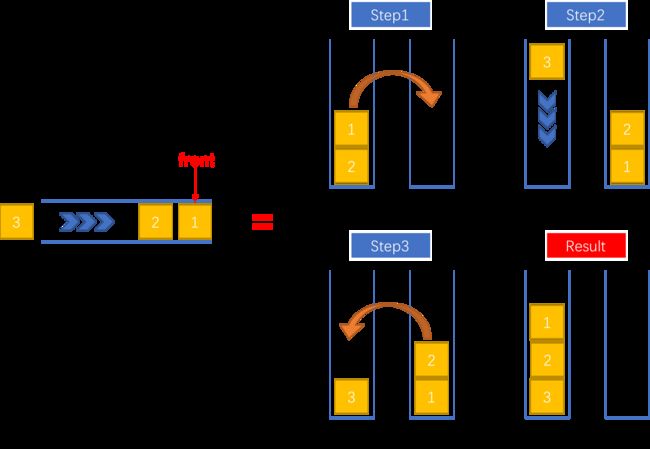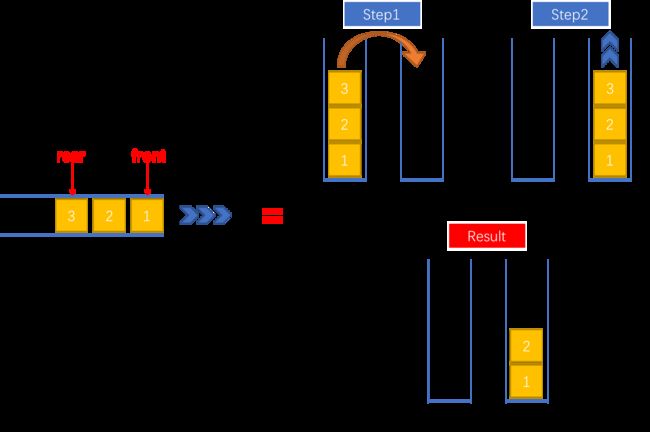【LeetCode题解】232_用栈实现队列(Implement-Queue-using-Stacks)
更多 LeetCode 题解笔记可以访问我的 github。
文章目录
- 描述
- 解法一:在一个栈中维持所有元素的出队顺序
- 思路
- 入队(push)
- 出队(pop)
- 查看队首(peek)
- 是否为空(empty)
- Java 实现
- Python 实现
- 解法二:一个栈入,一个栈出
- 思路
- 入队(push)
- 出队(pop)
- 查看队首(peek)
- 是否为空(empty)
- Java 实现
- Python 实现
描述
使用栈实现队列的下列操作:
- push(x) – 将一个元素放入队列的尾部。
- pop() – 从队列首部移除元素。
- peek() – 返回队列首部的元素。
- empty() – 返回队列是否为空。
示例:
MyQueue queue = new MyQueue();
queue.push(1);
queue.push(2);
queue.peek(); // 返回 1
queue.pop(); // 返回 1
queue.empty(); // 返回 false
说明:
- 你只能使用标准的栈操作 – 也就是只有
push to top,peek/pop from top,size, 和is empty操作是合法的。 - 你所使用的语言也许不支持栈。你可以使用 list 或者 deque(双端队列)来模拟一个栈,只要是标准的栈操作即可。
- 假设所有操作都是有效的 (例如,一个空的队列不会调用 pop 或者 peek 操作)。
解法一:在一个栈中维持所有元素的出队顺序
思路
队列是一种先入先出(first in first out, FIFO)的数据结构,而栈是一种后入先出(last in first out, LIFO)的数据结构。因此,如果要使用栈来达到队列的效果,即用有后入先出性质的数据结构来实现先入先出的效果,需要借用两个栈来改变元素的出队顺序。当然,借用两个栈来实现队列也有不同的实现方式,这一节介绍第一种实现方式,在下一小节介绍第二种方式。
第一种方式是在一个栈中维持所有元素的出队顺序,即所有的元素在入队操作完成后只会保存在一个栈中,且其出栈的顺序和出队的顺序是一致的。下面对入队、出队等操作的底层实现分别进行讲解。
入队(push)
为了实现出栈顺序和出队顺序是一致的,入栈时必须将新的元素压入栈底。为了实现这种效果,在入队时,首先将栈1(假设栈1中保存所有的元素)中所有的元素弹出并压入栈2中,接着将新的元素压入栈1中,最后再将栈2中的所有弹出并压入栈1中。详细的步骤如图1所示。
图1:将一个元素入队
代码(Java)实现如下。
public void push(int x) {
// 将栈1中的所有元素弹出并压入栈2中
while (!s1.isEmpty()) {
s2.push(s1.pop());
}
// 将新的元素压入栈1
s1.push(x);
// 将栈2的所有元素弹出并压入栈1
while (!s2.isEmpty()) {
s1.push(s2.pop());
}
}
复杂度分析如下:
- 时间复杂度: O ( n ) O(n) O(n),其中 n n n 表示入队时队列元素的数目,即栈1中元素的数目。入队时,栈1中的元素需要进行出栈和入栈两次,需要 4 n 4n 4n 次操作,再加上新的元素的一次入栈操作,总的操作次数为 4 n + 1 4n + 1 4n+1 次。由于栈的入栈和出栈的时间复杂度是 O ( 1 ) O(1) O(1) 的,因此,入队的时间复杂度是 O ( n ) O(n) O(n) 的
- 空间复杂度: O ( n ) O(n) O(n)
出队(pop)
出队操作比较简单,由于栈1中元素的出栈顺序和队列的出队顺序一致,因此,只需要弹出栈顶元素即可完成出队操作。
public int pop() {
if (s1.isEmpty()) {
throw new IllegalArgumentException("[ERROR] The queue is empty!");
}
return s1.pop();
}
复杂度分析如下:
- 时间复杂度: O ( 1 ) O(1) O(1)
- 空间复杂度: O ( 1 ) O(1) O(1)
查看队首(peek)
与出队操作类似,只需要查看栈1栈顶的元素即可完成查看队首的操作。
public int peek() {
if (s1.isEmpty()) {
throw new IllegalArgumentException("[ERROR] The queue is empty!");
}
return s1.peek();
}
复杂度分析如下:
- 时间复杂度: O ( 1 ) O(1) O(1)
- 空间复杂度: O ( 1 ) O(1) O(1)
是否为空(empty)
由于栈1中保存队列的所有元素,因此只需要判断栈1是否为空即可知道队列是否为空。
public boolean empty() {
return s1.isEmpty();
}
复杂度分析如下:
- 时间复杂度: O ( 1 ) O(1) O(1)
- 空间复杂度: O ( 1 ) O(1) O(1)
Java 实现
class MyQueue {
private Stack<Integer> s1;
private Stack<Integer> s2;
/** Initialize your data structure here. */
public MyQueue() {
s1 = new Stack<>();
s2 = new Stack<>();
}
/** Push element x to the back of queue. */
public void push(int x) {
while (!s1.isEmpty()) {
s2.push(s1.pop());
}
s1.push(x);
while (!s2.isEmpty()) {
s1.push(s2.pop());
}
}
/** Removes the element from in front of queue and returns that element. */
public int pop() {
if (s1.isEmpty()) {
throw new IllegalArgumentException("[ERROR] The queue is empty!");
}
return s1.pop();
}
/** Get the front element. */
public int peek() {
if (s1.isEmpty()) {
throw new IllegalArgumentException("[ERROR] The queue is empty!");
}
return s1.peek();
}
/** Returns whether the queue is empty. */
public boolean empty() {
return s1.isEmpty();
}
}
Python 实现
class MyQueue:
def __init__(self):
"""
Initialize your data structure here.
"""
self._s1, self._s2 = [], []
def push(self, x):
"""
Push element x to the back of queue.
:type x: int
:rtype: void
"""
while self._s1:
self._s2.append(self._s1.pop())
self._s1.append(x)
while self._s2:
self._s1.append(self._s2.pop())
def pop(self):
"""
Removes the element from in front of queue and returns that element.
:rtype: int
"""
return self._s1.pop()
def peek(self):
"""
Get the front element.
:rtype: int
"""
return self._s1[-1]
def empty(self):
"""
Returns whether the queue is empty.
:rtype: bool
"""
return not self._s1
解法二:一个栈入,一个栈出
思路
解法二的实现方式与解法一有点不同,按照功能的不同,解法二将两个栈一个用于入队,一个用于出队。假设栈 inStack 用于实现入队操作,栈 outStack 用于实现出队操作。下面对入队、出队等操作的底层实现分别进行讲解。
入队(push)
入队操作比较简单,直接将新的元素压入栈 inStack 中,同时,对于第一个进入栈中的元素,我们用一个变量 front 保存起来,用于表示栈 inStack 这个队列的队首。
/** Push element x to the back of queue. */
public void push(int x) {
if (inStack.empty()) {
front = x;
}
inStack.push(x);
}
复杂度分析如下:
- 时间复杂度: O ( 1 ) O(1) O(1)
- 空间复杂度: O ( n ) O(n) O(n),需要额外的空间用于存储队列元素
出队(pop)
在入队时,由于先入的元素处于输入栈 inStack 的栈底,因此,为了能够弹出栈底的元素实现出队操作,需要将输入栈 inStack 中的元素弹出并压入到输出栈 outStack 中。此时,输出栈 outStack 中元素的出栈顺序和队列的出队顺序是一致的。只要输出栈 outStack 中还有元素,每次执行出队操作只需要将栈 outStack 的栈顶元素弹出即可。当输出栈 outStack 为空时,执行出队操作则需要先将输入栈 inStack 中的元素弹出并压入输出栈。详细的步骤如图2所示。
图2:将一个元素出队
代码(Java)实现如下。
/** Removes the element from in front of queue and returns that element. */
public int pop() {
if (empty()) {
throw new IllegalArgumentException("[ERROR] The queue is empty!");
}
if (outStack.isEmpty()) {
while (!inStack.isEmpty()) {
outStack.push(inStack.pop());
}
}
return outStack.pop();
}
复杂度分析如下:
- 时间复杂度:均摊时间复杂度为 O ( 1 ) O(1) O(1),最坏情况下,时间复杂度为 O ( n ) O(n) O(n),更为详细的均摊复杂度分析可以查看官网的文章
- 空间复杂度: O ( 1 ) O(1) O(1)
查看队首(peek)
与出队操作类似,当输出栈 outStack 不为空时,只需要返回输出栈 outStack 的栈顶元素即可。不同的是,由于我们用变量 front 存储了输入栈最先进入的元素,因此,当输出栈 outStack 为空时,不需要再将输入栈 inStack 的元素弹出并压入到输出栈 outStack 中便可以得到当前队首的元素。
/** Get the front element. */
public int peek() {
if (empty()) {
throw new IllegalArgumentException("[ERROR] The queue is empty!");
}
if (!outStack.isEmpty()) {
return outStack.peek();
} else {
return front;
}
}
复杂度分析如下:
- 时间复杂度: O ( 1 ) O(1) O(1),借助于变量
front,可以使得peek操作在任意情况下都是 O ( 1 ) O(1) O(1) 的时间复杂度 - 空间复杂度: O ( 1 ) O(1) O(1)
是否为空(empty)
由于两个都有可以存在元素,因此,要判断队列是否为空,需要同时判断两个栈。
/** Returns whether the queue is empty. */
public boolean empty() {
return inStack.isEmpty() && outStack.isEmpty();
}
复杂度分析如下:
- 时间复杂度: O ( 1 ) O(1) O(1)
- 空间复杂度: O ( 1 ) O(1) O(1)
Java 实现
class MyQueue {
/**
* The stack used to implement enqueue functionality
*/
private Stack<Integer> inStack;
/**
* The stack used to implement dequeue functionality
*/
private Stack<Integer> outStack;
/**
* The front element in the stack `inStack` 's queue
*/
private int front;
/** Initialize your data structure here. */
public MyQueue2() {
inStack = new Stack<>();
outStack = new Stack<>();
}
/** Push element x to the back of queue. */
public void push(int x) {
if (inStack.empty()) {
front = x;
}
inStack.push(x);
}
/** Removes the element from in front of queue and returns that element. */
public int pop() {
if (empty()) {
throw new IllegalArgumentException("[ERROR] The queue is empty!");
}
if (outStack.isEmpty()) {
while (!inStack.isEmpty()) {
outStack.push(inStack.pop());
}
}
return outStack.pop();
}
/** Get the front element. */
public int peek() {
if (empty()) {
throw new IllegalArgumentException("[ERROR] The queue is empty!");
}
if (!outStack.isEmpty()) {
return outStack.peek();
} else {
return front;
}
}
/** Returns whether the queue is empty. */
public boolean empty() {
return inStack.isEmpty() && outStack.isEmpty();
}
}
Python 实现
class MyQueue:
def __init__(self):
"""
Initialize your data structure here.
"""
self._in_stack, self._out_stack, self._front = [], [], None
def push(self, x):
"""
Push element x to the back of queue.
:type x: int
:rtype: void
"""
if not self._in_stack:
self._front = x
self._in_stack.append(x)
def pop(self):
"""
Removes the element from in front of queue and returns that element.
:rtype: int
"""
if self.empty():
raise Exception("[ERROR] The queue is empty!")
if not self._out_stack:
while self._in_stack:
self._out_stack.append(self._in_stack.pop())
return self._out_stack.pop()
def peek(self):
"""
Get the front element.
:rtype: int
"""
if self.empty():
raise Exception("[ERROR] The queue is empty!")
if not self._out_stack:
return self._front
else:
return self._out_stack[-1]
def empty(self):
"""
Returns whether the queue is empty.
:rtype: bool
"""
return not self._in_stack and not self._out_stack

